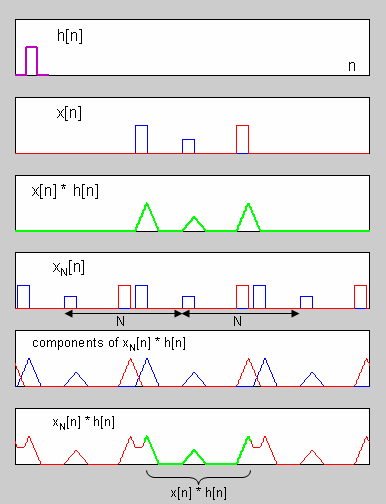
Circular convolution
Encyclopedia
The circular convolution, also known as cyclic convolution, of two aperiodic functions occurs when one of them is convolved in the normal way with a periodic summation of the other function. That situation arises in the context of the Circular convolution theorem. The identical operation can also be expressed in terms of the periodic summations of both functions, if the infinite integration interval is reduced to just one period. That situation arises in the context of the discrete-time Fourier transform
(DTFT) and is also called periodic convolution. In particular, the transform (DTFT) of the product of two discrete sequences is the periodic convolution of the transforms of the individual sequences.
For a periodic function
xT, with period T, the convolution
with another function, h, is also periodic, and can be expressed in terms of integration over a finite interval as follows:

where to is an arbitrary parameter, and hT is a periodic summation of h, defined by:

This operation is a periodic convolution of functions xT and hT. When xT is expressed as the periodic summation of another function, x, the same operation may also be referred to as a circular convolution of functions h and x.

This corresponds to matrix multiplication
, and the kernel of the integral transform is a circulant matrix
.

A case of great practical interest is illustrated in the figure. The duration of the x sequence is N (or less), and the duration of the h sequence is significantly less. Then many of the values of the circular convolution are identical to values of x∗h, which is actually the desired result when the h sequence is a finite impulse response
(FIR) filter. Furthermore, the circular convolution is very efficient to compute, using a fast Fourier transform
(FFT) algorithm and the circular convolution theorem.
There are also methods for dealing with an x sequence that is longer than a practical value for N. The sequence is divided into segments (blocks) and processed piecewise. Then the filtered segments are carefully pieced back together. Edge effects are eliminated by overlapping either the input blocks or the output blocks. To help explain and compare the methods, we discuss them both in the context of an h sequence of length 201 and an FFT size of N = 1024.
Overlapping input blocks
This method uses a block size equal to the FFT size (1024). We describe it first in terms of normal or linear convolution. When a normal convolution is performed on each block, there are start-up and decay transients at the block edges, due to the filter latency (200-samples). Only 824 of the convolution outputs are unaffected by edge effects. The others are discarded, or simply not computed. That would cause gaps in the output if the input blocks are contiguous. The gaps are avoided by overlapping the input blocks by 200 samples. In a sense, 200 elements from each input block are "saved" and carried over to the next block. This method is referred to as overlap-save
, although the method we describe next requires a similar "save" with the output samples.
When the DFT or FFT is used, we don't have the option of not computing the affected samples, but the leading and trailing edge-effects are overlapped and added because of circular convolution. Consequently, the 1024-point inverse FFT (IFFT) output contains only 200 samples of edge effects (which are discarded) and the 824 unaffected samples (which are kept). To illustrate this, the fourth frame of the figure at right depicts a block that has been periodically (or "circularly") extended, and the fifth frame depicts the individual components of a linear convolution performed on the entire sequence. The edge effects are where the contributions from the extended blocks overlap the contributions from the original block. The last frame is the composite output, and the section colored green represents the unaffected portion.
Overlapping output blocks
This method is known as overlap-add. In our example, it uses contiguous input blocks of size 824 and pads each one with 200 zero-valued samples. Then it overlaps and adds the 1024-element output blocks. Nothing is discarded, but 200 values of each output block must be "saved" for the addition with the next block. Both methods advance only 824 samples per 1024-point IFFT, but overlap-save avoids the initial zero-padding and final addition.
Discrete-time Fourier transform
In mathematics, the discrete-time Fourier transform is one of the specific forms of Fourier analysis. As such, it transforms one function into another, which is called the frequency domain representation, or simply the "DTFT", of the original function . But the DTFT requires an input function...
(DTFT) and is also called periodic convolution. In particular, the transform (DTFT) of the product of two discrete sequences is the periodic convolution of the transforms of the individual sequences.
For a periodic function
Periodic function
In mathematics, a periodic function is a function that repeats its values in regular intervals or periods. The most important examples are the trigonometric functions, which repeat over intervals of length 2π radians. Periodic functions are used throughout science to describe oscillations,...
xT, with period T, the convolution
Convolution
In mathematics and, in particular, functional analysis, convolution is a mathematical operation on two functions f and g, producing a third function that is typically viewed as a modified version of one of the original functions. Convolution is similar to cross-correlation...
with another function, h, is also periodic, and can be expressed in terms of integration over a finite interval as follows:

where to is an arbitrary parameter, and hT is a periodic summation of h, defined by:

This operation is a periodic convolution of functions xT and hT. When xT is expressed as the periodic summation of another function, x, the same operation may also be referred to as a circular convolution of functions h and x.
Discrete sequences
Similarly, for discrete sequences and period N, we can write the circular convolution of functions h and x as:
This corresponds to matrix multiplication
Matrix multiplication
In mathematics, matrix multiplication is a binary operation that takes a pair of matrices, and produces another matrix. If A is an n-by-m matrix and B is an m-by-p matrix, the result AB of their multiplication is an n-by-p matrix defined only if the number of columns m of the left matrix A is the...
, and the kernel of the integral transform is a circulant matrix
Circulant matrix
In linear algebra, a circulant matrix is a special kind of Toeplitz matrix where each row vector is rotated one element to the right relative to the preceding row vector. In numerical analysis, circulant matrices are important because they are diagonalized by a discrete Fourier transform, and hence...
.
Example

A case of great practical interest is illustrated in the figure. The duration of the x sequence is N (or less), and the duration of the h sequence is significantly less. Then many of the values of the circular convolution are identical to values of x∗h, which is actually the desired result when the h sequence is a finite impulse response
Finite impulse response
A finite impulse response filter is a type of a signal processing filter whose impulse response is of finite duration, because it settles to zero in finite time. This is in contrast to infinite impulse response filters, which have internal feedback and may continue to respond indefinitely...
(FIR) filter. Furthermore, the circular convolution is very efficient to compute, using a fast Fourier transform
Fast Fourier transform
A fast Fourier transform is an efficient algorithm to compute the discrete Fourier transform and its inverse. "The FFT has been called the most important numerical algorithm of our lifetime ." There are many distinct FFT algorithms involving a wide range of mathematics, from simple...
(FFT) algorithm and the circular convolution theorem.
There are also methods for dealing with an x sequence that is longer than a practical value for N. The sequence is divided into segments (blocks) and processed piecewise. Then the filtered segments are carefully pieced back together. Edge effects are eliminated by overlapping either the input blocks or the output blocks. To help explain and compare the methods, we discuss them both in the context of an h sequence of length 201 and an FFT size of N = 1024.
Overlapping input blocks
This method uses a block size equal to the FFT size (1024). We describe it first in terms of normal or linear convolution. When a normal convolution is performed on each block, there are start-up and decay transients at the block edges, due to the filter latency (200-samples). Only 824 of the convolution outputs are unaffected by edge effects. The others are discarded, or simply not computed. That would cause gaps in the output if the input blocks are contiguous. The gaps are avoided by overlapping the input blocks by 200 samples. In a sense, 200 elements from each input block are "saved" and carried over to the next block. This method is referred to as overlap-save
Overlap-save method
Overlap–save is the traditional name for an efficient way to evaluate the discrete convolution between a very long signal x[n] and a finite impulse response filter h[n]:...
, although the method we describe next requires a similar "save" with the output samples.
When the DFT or FFT is used, we don't have the option of not computing the affected samples, but the leading and trailing edge-effects are overlapped and added because of circular convolution. Consequently, the 1024-point inverse FFT (IFFT) output contains only 200 samples of edge effects (which are discarded) and the 824 unaffected samples (which are kept). To illustrate this, the fourth frame of the figure at right depicts a block that has been periodically (or "circularly") extended, and the fifth frame depicts the individual components of a linear convolution performed on the entire sequence. The edge effects are where the contributions from the extended blocks overlap the contributions from the original block. The last frame is the composite output, and the section colored green represents the unaffected portion.
Overlapping output blocks
This method is known as overlap-add. In our example, it uses contiguous input blocks of size 824 and pads each one with 200 zero-valued samples. Then it overlaps and adds the 1024-element output blocks. Nothing is discarded, but 200 values of each output block must be "saved" for the addition with the next block. Both methods advance only 824 samples per 1024-point IFFT, but overlap-save avoids the initial zero-padding and final addition.
See also
- Interpretations of the discrete Fourier transformA derivation of the discrete Fourier transformIn mathematics, computer science, and electrical engineering, the discrete Fourier transform , occasionally called the finite Fourier transform, is a transform for Fourier analysis of finite-domain discrete-time signals. As with most Fourier analysis, it expresses an input function in terms of a...
- Discrete Hilbert transform
- Circulant matrixCirculant matrixIn linear algebra, a circulant matrix is a special kind of Toeplitz matrix where each row vector is rotated one element to the right relative to the preceding row vector. In numerical analysis, circulant matrices are important because they are diagonalized by a discrete Fourier transform, and hence...

